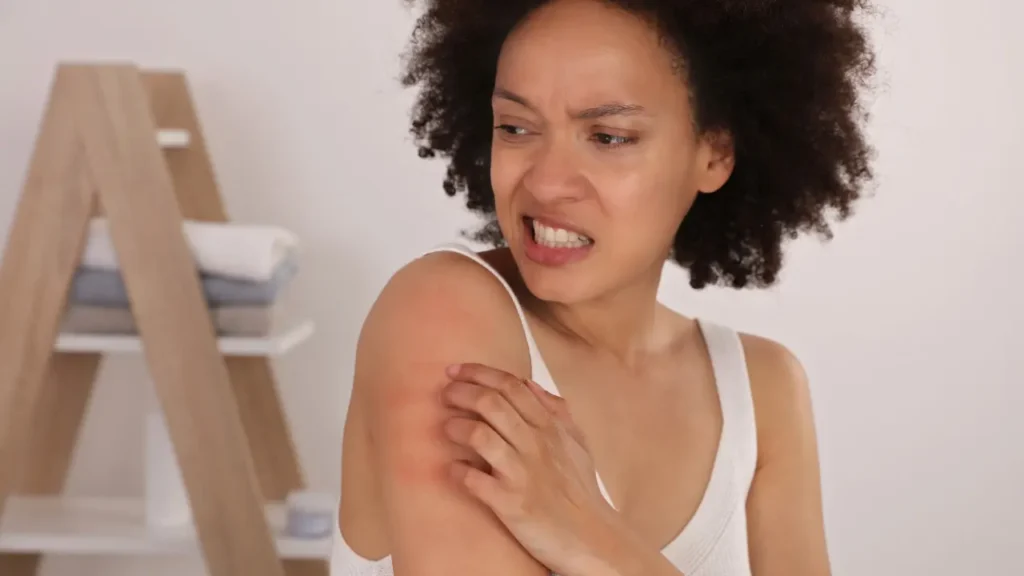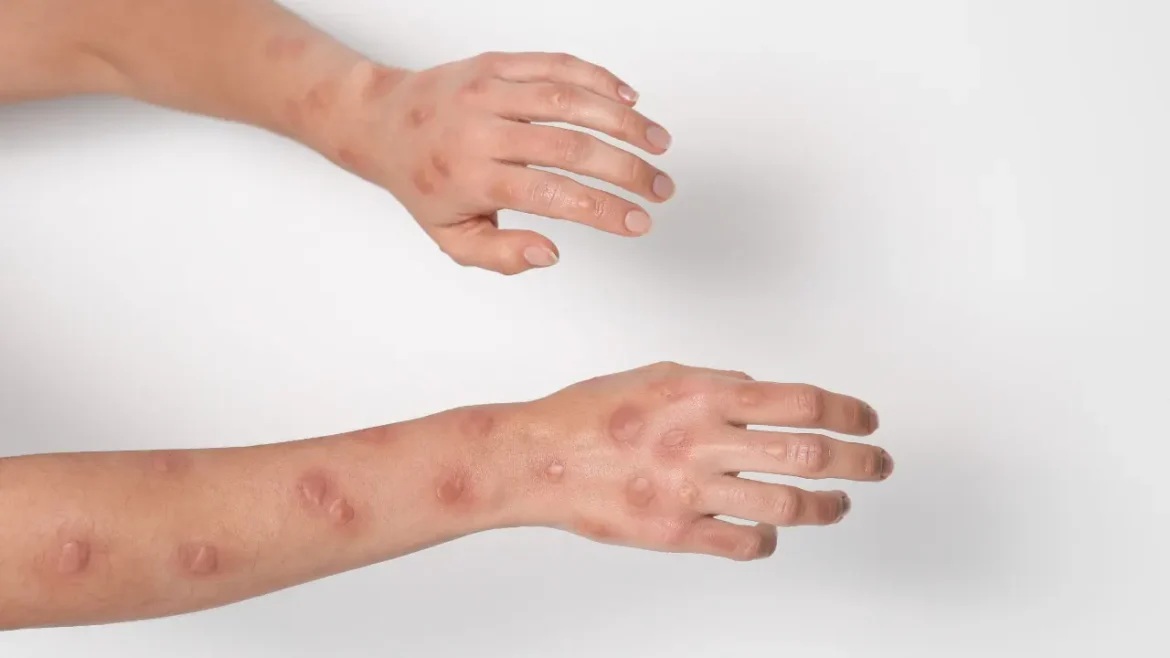Description of Monkeypox Rash
The infectious disease that causes Monkeypox is known as an orthopoxvirus, or Monkeypox. Although prevalent in specific regions of central and west Africa, sporadic instances of Monkeypox have also been reported elsewhere across the world. Since Monkeypox causes a distinct rash, it is simpler to identify than some other infectious diseases. Often, the face and trunk show the earliest signs of the Monkeypox rash, which develops into raised reddish-brown spots.
Over time, these patches began to spread across the body. These lesions grow into vesicles filled with fluid that eventually crust and scab over. Alongside the rash, other symptoms like fever, headache, muscle aches, and general fatigue are possible for those with Monkeypox. The rash may linger for weeks to several months.
You May Also Like:
HOO RAA CBD VS PARTNERED PROCESS CBD
CBD CONTRACT MANUFACTURER –TOP 5 BEST IN CLASS FOR 2022
Monkeypox rash: Description, Causes, And Treatment Protocol is an original (HealthXWire) article.
Possible Causes
The Monkeypox virus, typically spread by interacting with infected people or animals, is the primary trigger of Monkeypox Rash. Transmission may be aided by immediate interactions with respiratory droplets, body fluids, or contaminated items like bedding or clothing. Transmission between individuals has been noted in a small number of circumstances.
Exacerbating & Mitigating Factors of Monkeypox Rash
The exacerbating factors of Monkeypox Rash include:
Pre-existing Skin Disorders: Psoriasis, eczema, or dermatitis symptoms may worsen in people who already have them during a Monkeypox Rash outbreak. The already present skin irritation and impaired skin barrier function may make the rash more uncomfortable.
Compromised Immune Function: Serious kinds of monkeypox rash are more likely to affect people with compromised immune systems. HIV/AIDS, immunosuppressive medication, and other disorders that impair immune function might worsen symptoms and cause more complications.
Diagnostic and Therapeutic Delays: The Monkeypox virus can spread more quickly if the patient’s diagnosis and start of the recommended therapy are delayed, which can result in the rash developing in more severe ways. Delaying therapy might worsen the disease and lengthen recovery time by raising the risk of subsequent infections.
The mitigating factors of Monkeypox Rash include:
Immediate Medical Attention: People should visit their doctors right away, so they can get care as soon as symptoms appear. Early intervention may decrease symptoms, control outcomes, and help your body’s immune system fight the infection.
Hygiene Practices: The possibility of infection and the transmission of the virus responsible for Monkeypox may be decreased by practicing proper hygiene, which includes routine handwashing involving water and soap, utilizing hand sanitizers, and keeping living spaces clean.
Good Overall Health: A healthier immune system can result from activities like regular exercise, a healthy diet, and enough rest. The duration and extent of Monkeypox Rash may be minimized by an effective immune system.
Isolation and Infection Prevention Techniques: Monkeypox must be isolated and proper infection control procedures must be put in place to stop future spread. Isolation helps stop the virus’s transmission, safeguards susceptible groups, and lessens the disease’s effects.
Early Identification and Treatment: Effective care of Monkeypox Rash depends on prompt diagnosis and identification. The intensity and effects of the rash on someone can be lessened with early detection, rapid medical intervention, effective treatment, and preventive measures.

Types of Treatment for Monkeypox Rash
Monkeypox Rash is often treated with symptomatic alleviation and supportive care. These involve taking steps to lower fever, ease pain and suffering, stop secondary infections, and proper hydration and nutrition. To stop future transmission, isolation measures are essential. The usual course of action for treating monkeypox consists of:
Symptomatic Relief:
- Fever reduction
To lower fever and ease related discomfort, over-the-counter antipyretic drugs like ibuprofen or acetaminophen are examples.
- Pain management
Nonsteroidal anti-inflammatory medicines (NSAIDs), such as naproxen or ibuprofen, can ease the joint and muscle pain brought on by the Monkeypox Rash.
Hydration and Nutrition:
Adequate fluid intake
- In times of illness, staying well hydrated is crucial. Oral rehydration solutions and plenty of water consumption help stop dehydration.
- Balanced diet
A balanced diet comprised of fruits, whole grains, vegetables, and lean meats may enhance overall health and hasten the healing process.
Skin Care:
- Maintaining cleanliness
Regularly bathing the affected regions of your body using gentle soap and water encourages healing and aids in the prevention of subsequent infections.
- Topical treatments
The skin can be soothed by using topical antihistamines or over-the-counter calamine lotions.
Preventing Secondary Infections:
- Good hygiene practices
Habitual hand washing using water and soap or hand sanitizers containing alcohol can lower the possibility of infection and its transmission.
- Wound care
Reduce the chance of bacterial infection by maintaining the rash area dry and clean and refraining from picking or scratching the sores.
- Measures for Isolation: Monkeypox sufferers must be kept apart in order to prevent the virus from infecting others. It is crucial to adhere to the proper infection control practices, which include donning protective gear.


Treatment Options
A majority of methods for treating Monkeypox Rash focus on supportive care which eases symptoms and hastens the process of healing. Monkeypox does not have a specific antiviral medication, but the following remedies are routinely employed:
Antiviral Medications: Doctors may recommend antiviral medications like cidofovir or brincidofovir in extreme situations are for people who are at high risk of problems. These drugs may shorten and lessen the intensity of Monkeypox symptoms.
Antihistamines: Oral antihistamines or topical antihistamine lotions can relieve itching and lessen the desire to touch the rash.
Pain Relievers: Monkeypox rash discomfort and pain might be reduced by taking over-the-counter painkillers like acetaminophen. You should follow the dosage recommendations and seek medical advice as necessary.
Nutritional Supplements: A healthy diet is crucial for strengthening the immune function and accelerating the healing process, even if no particular dietary supplements have been shown to effectively cure Monkeypox rash. The following dietary supplements could promote immune function and accelerate healing:
- Vitamin C
With respect to assisting in the development of white blood cells, vitamin C functions as an antioxidant, protecting against cellular deterioration. Vitamin C is naturally present in foods like green leafy vegetables, citrus fruits, bell peppers, and strawberries. When your diet is not sufficient, consider exploring vitamin C supplements.
- Vitamin D
The immune system depends heavily on vitamin D and viral infections respond better when it is present. Vitamin D may additionally be found in fortified dairy items, fatty fish, and supplements, although sunlight exposure remains the most potent natural source.
- Zinc
Zinc is essential for healthy wound healing and has a role in several immunological processes. Poultry, beef, seeds, and nuts are some examples of foods high in zinc.
Notably, dietary supplements must not be used in place of a healthy diet. They ought to be utilized as supplemental measures to boost immunological and general health. Speak with a healthcare provider or a registered dietitian to ascertain whether supplementing is advised and to review recommended dosages.
Natural and Herbal Remedies: Although there is little scientific evidence explicitly supporting the use of herbal and natural treatments for monkeypox rash, some of these treatments may have the ability to reduce symptoms and enhance general health. It is vital to keep in mind that such treatments must be used with regular medical attention, under the guidance of a healthcare professional. These herbal and natural treatments have been recommended:
- Aloe vera gel
The calming and anti-inflammatory qualities of aloe vera may aid to reduce irritation and encourage skin healing. Natural aloe vera gel should be applied topically on the areas impacted.
- Coconut oil
Coconut oil offers hydrating qualities that could ease dry, irritated skin. To soothe and hydrate the affected regions, use coconut oil that is organic and cold-pressed.
- Tea tree oil
The antiviral and antibacterial effects of tea tree oil. Applying tea tree oil topically on the rash requires dilution with carrier oils like coconut oil. It is crucial to carry out a patch test initially and keep it away from exposed wounds.
- Elderberry
Elderberry has long been used to treat viral infections because of its immune-boosting qualities. It is offered as tea, syrup, or capsules.
- Garlic
The antibacterial properties of garlic may enhance immune system health. After speaking with a healthcare provider, include fresh garlic in one’s diet or think about taking garlic supplements.
- Echinacea
Echinacea can help the body defend against infections and is thought to support immunological function. There are several different forms of it, like capsules, teas, and extracts.
The effectiveness and safety of the aforementioned herbal and natural treatments for Monkeypox Rash do not require in-depth research. Always seek medical advice before adopting any herbal or natural therapies, particularly if you have underlying medical issues, use medication, or are pregnant or nursing. They might help those persons decide whether these treatments are suitable for their particular circumstances by offering them individualized recommendations.


Monkeypox Rash:
Conclusion
Monkeypox Rash presents itself in a variety of symptoms that cause physical discomfort and require medical attention. While painful for all sufferers, some people may be vulnerable to particularly intense cases of the infection due to their preexisting medical conditions and medications. Luckily, due to its global prevalence, treatment plans are accessible and available, though it does take effort to eradicate. Use this article as part of your research to help yourself and those you care for safe from or when contracting Monkeypox.


- “Signs and Symptoms.” Retrieved from: https://www.cdc.gov/poxvirus/mpox/symptoms/index.html
- “Dermatologist Explains What the MPOX (Monkeypox) Rash Looks Like.” Retrieved from: https://www.aad.org/public/diseases/a-z/monkeypox-rash
- “These Pictures of Monkeypox on Skin May Help You Identify Rashes or Lesions.” Retrieved from: https://www.health.com/news/monkeypox-pictures
- “Mpox (monkeypox).” Retrieved from: https://www.who.int/news-room/fact-sheets/detail/monkeypox
Important Note: The information contained in this article is for general informational purposes only, and should not be construed as health or medical advice, nor is it intended to diagnose, prevent, treat, or cure any disease or health condition. Before embarking on any diet, fitness regimen, or program of nutritional supplementation, it is advisable to consult your healthcare professional in order to determine its safety and probable efficacy in terms of your individual state of health.
Regarding Nutritional Supplements Or Other Non-Prescription Health Products: If any nutritional supplements or other non-prescription health products are mentioned in the foregoing article, any claims or statements made about them have not been evaluated by the U.S. Food and Drug Administration, and such nutritional supplements or other health products are not intended to diagnose, treat, cure, or prevent any disease.
Table of Contents


